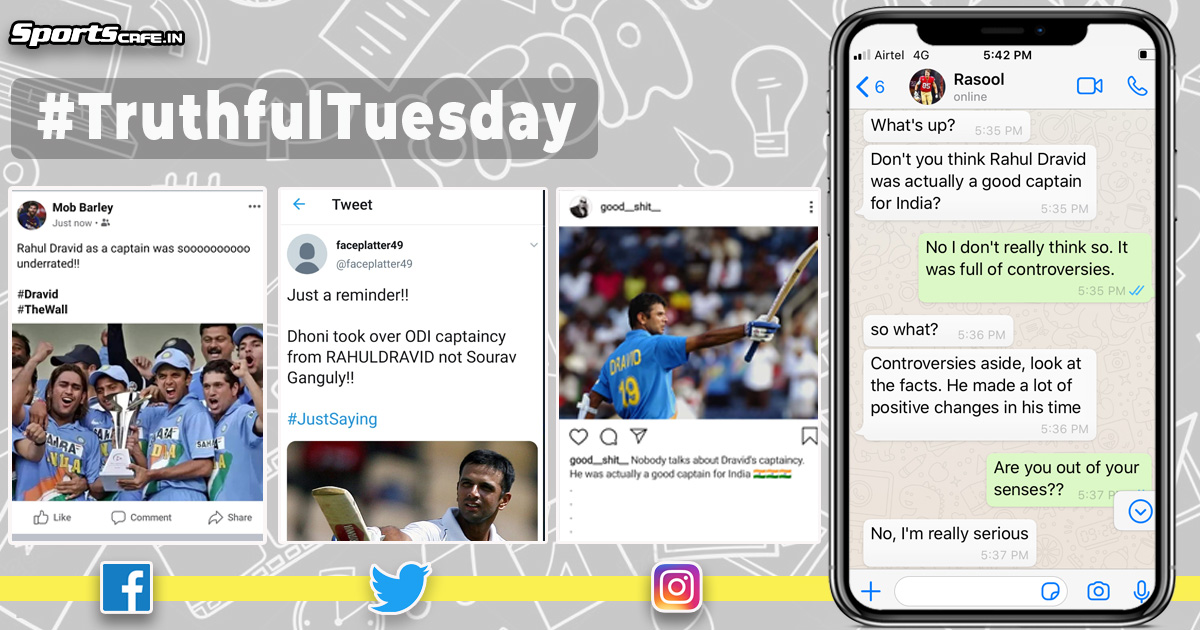Truthful Tuesday | Rahul Dravid was a better captain than he is given credit for
Rahul Dravid, the man himself, was one of the Fab 4 of the golden era of India cricket but when it came to his captaincy, the phase has always been looked down upon. So, in this week’s edition of ‘Truthful Tuesday’, we break the entire issue down and look at the truthful and factual side of it.

Bangladesh’s celebration for defeating Team India in a Group stage game of the ICC 2007 World Cup still hurt Indian fans. As a fallout of that defeat, India were knocked out of the World Cup. From being finalists in the 2003 World Cup to a shameful exit in the succeeding one, all blame was put on the captain and the coach. Obviously, Greg Chappell’s era wasn’t seen as a constructive one by anyone, something that Harbhajan Singh all his life and Sachin Tendulkar in his autobiography, years later, expressed. But the pressure was so much on Dravid, that only months later, in September 2007, Dravid had to step down from captaincy. Consequently, as much as he is given credit for being one of the greatest players in Indian cricket history, his captaincy is seen but as a forgettable period.
By the end of the 20th century, the India cricket team had established for itself a core batting side, headed by Sachin Tendulkar, that was better than the nation had ever seen. Hence, the ‘golden era’ had begun. After Tendulkar’s ‘failure’ as a captain, Sourav Ganguly - strong-headed individual and great limited-overs batsman- was the natural selection for the leadership role. Under him, as former England captain Nasser Hossain puts it, the Indian team turned into a ‘nasty bunch’. Something that the world of cricket had never seen before. So Dada’s era of captaincy became a legacy and the ones that followed were compared to the one Ganguly had set up. Then came the era of MS Dhoni, that saw India lifting the first-ever T20 World Cup and the nations first World Cup title, in 2011, since 1983.
Following Ganguly’s controversial dethroning as captain, Rahul Dravid was put to captaincy and a whole new controversy had started over it. The Greg Chappell era was indeed a dark one in Indian cricket and many believe that Rahul Dravid’s captaincy was just an outcome of it, hence seen as Katelyn Stark treated Jon Snow. Perhaps, Ganguly would’ve remained captain if the fallout with Greg Chappell never happened. But whatever happens, happens for a reason. And this eventuality, of Dravid becoming the captain, was indeed one. Yes, we don’t talk about it the way we talk about the 'Ganguly-era', the 'Dhoni-era' and now the 'Kohli-era'. But that doesn’t take away the contributions of the ‘The Wall’ in Indian cricket.
Dravid, the graced and the celebrated batsman, was named successor to Ganguly in October 2005, after the infamous dropping of the latter. And Dravid went on to captain India in a total of 25 Tests and 79 ODIs, winning eight and 42, respectively. Under Dravid's ODI captaincy, India became a force in successful ODI chases - winning 27 in chases, of which 17 were consecutive wins. He started off his captaincy with a home series against Sri Lanka then went on to register wins against England and Pakistan as well.
Sourav Ganguly was known to revolutionize what the word captain means in Indian cricket. Not only did he make them fierce but also revolutionized cricket in all senses. He made Virender Sehwag an opener and discovered the talent of MS Dhoni. In order to relieve Rahul Dravid of captaincy duties, following the 2003 World Cup, a 23-year-old Dhoni was incorporated to the side in 2004. Just six months into his career Dhoni became a familiar name as he smashed that famous 148 against Pakistan at Vizag in April 2005. But it was more on and off than it seemed. In fact, it was only under Dravid’s captaincy that Dhoni’s batting actually flourished.
Later that year, in the aforementioned seven-match home series against Lanka, it was Dravid who promoted Dhoni to Number 3 while chasing a big total of 299 and that was when Dhoni stunned one and all with his brilliant unbeaten 183 to help India win. Further on, his finishing skills were discovered when he helped Yuvraj Singh complete successful chases in a couple of chases in the following ODI series against Pakistan.
Dhoni did bat at No. 6 in the 2007 World Cup, but the confidence in his batting and the overall foundation of his run-scoring and free-flowing sixes were discovered under Dravid. India did lose the 2007 World Cup, but Dravid’s leadership had weaved a giant of limited-overs cricket who would lead India to win the first-ever WT20 contest in history, in the same year.
Meanwhile, Dravid also experimented and did well with tweaking his predecessor’s four-bowler theory. Ganguly believed in having a full-fledged batsman in the lower down the order and opt for a mere four bowlers down the order. But Dravid had something else on his mind and implemented his own theory of how India needed its bowlers to rise to the occasion and deliver victories and not just the batsman. In fact, his ideologies were quite similar to ones the current Indian captain Virat Kohli has. Like having Irfan Pathan contributing as an all-rounder whilst also having four mainstream bowlers for a packed bowling attack. It is indeed similar to the one Kohli loves to follow with Hardik Pandya as the pace-bowling all-rounder with great hitting abilities and two more seam bowlers and a couple of spinners.
While Kohli and Ganguly’s style of captaincy are often compared due to their aggressive approach, it’s perhaps Dravid’s ideologies that map more with the current Indian captain. Had India defeated Bangladesh in the 2007 World Cup game, Dravid’s foundations and achievements would’ve been seen in a more fair-way. Again, as established, whatever happens, happens for a reason. As laidback be his personality, Dravid was actually a leader through and through and his contemporary achievements as a coach are but a testimony to the fact.

Comments
Sign up or log in to your account to leave comments and reactions
0 Comments